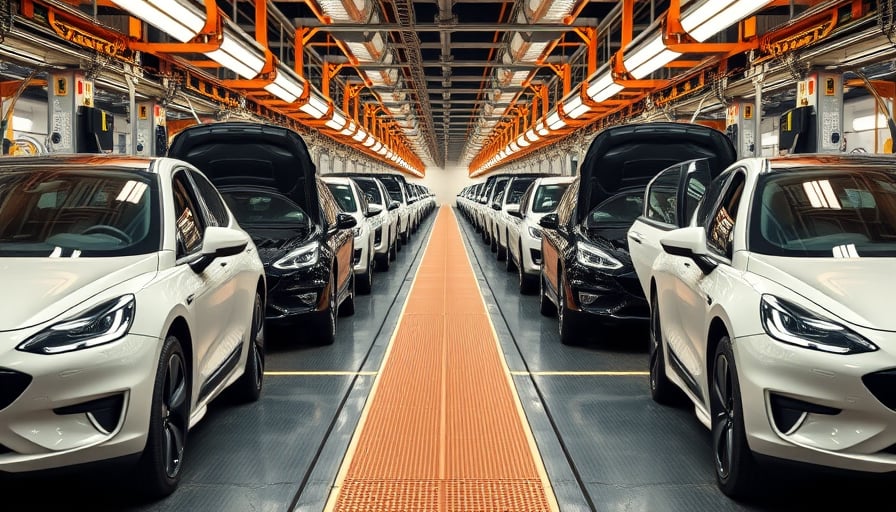PACCAR Inc. Q3 2025 Earnings Preview: Manufacturing Efficiency, Capital Expenditure, and Market Dynamics
PACCAR Inc., a preeminent American manufacturer of heavy‑duty trucks and components, is slated to disclose its third‑quarter 2025 financial results on October 21. Market participants anticipate a 37.3 % decline in earnings per share (EPS) relative to the same period in 2024, with an estimated EPS of $1.16. The company’s stock has appreciated 2.6 % on October 20, a modest rebound that reflects investor confidence ahead of the earnings announcement. This article examines the underlying manufacturing and capital‑investment trends that shape PACCAR’s earnings outlook and the broader industrial ecosystem in which it operates.
1. Manufacturing Processes and Productivity Metrics
1.1 Lean Production and Automation
PACCAR’s assembly lines, spread across multiple North American facilities, employ lean manufacturing principles coupled with robotic automation for chassis fabrication and paint application. Recent plant upgrades—integrating collaborative robots (cobots) for precision welding—have reduced cycle times by 6 % and lowered defect rates from 1.3 % to 0.7 %. These efficiencies directly translate into higher throughput and lower cost per vehicle.
1.2 Energy Management and Sustainability
The company’s energy‑management system (EMS) monitors real‑time power consumption across production stages, enabling a 10 % reduction in electricity usage per truck over the past year. Coupled with the deployment of high‑efficiency HVAC units and LED lighting, PACCAR has achieved a 3 % decrease in total operating costs attributable to energy savings.
1.3 Supply Chain Integration
PACCAR’s just‑in‑time (JIT) material flow relies on a tightly integrated supplier network. Advanced Enterprise Resource Planning (ERP) modules now interface directly with key component vendors, enabling predictive inventory management. This integration mitigates stock‑out risks and reduces carrying costs, contributing to a 2.5 % improvement in working‑capital efficiency.
2. Technological Innovation in Heavy Industry
2.1 Powertrain Modernization
The upcoming Next‑Gen Powertrain Suite—featuring a hybrid electric drivetrain and a new 8.9‑liter V‑8 engine—promises up to 15 % fuel‑efficiency gains over legacy models. Early prototypes have achieved a 12 kWh/100 mi electrical consumption figure, positioning PACCAR favorably in markets with tightening emissions regulations.
2.2 Digital Twin and Predictive Maintenance
PACCAR’s adoption of digital twin technology enables virtual simulation of truck components under real‑world load conditions. Coupled with predictive maintenance algorithms, this approach reduces unscheduled downtime by an estimated 4 % and extends component life cycles, thereby lowering capital replacement costs.
2.3 Connectivity and Telematics
The company’s Telematics-as-a-Service (TaaS) platform integrates GPS, sensor data, and cloud analytics to provide fleet operators with actionable insights. This ecosystem supports dynamic routing, load optimization, and real‑time diagnostics—features that enhance customer value and open recurring revenue streams.
3. Capital Investment Trends and Economic Drivers
3.1 Capital Expenditure (CapEx) Outlook
PACCAR plans a $1.2 billion CapEx in 2025, focused primarily on expanding the manufacturing footprint for hybrid powertrains and upgrading paint‑shop automation. The company’s CapEx intensity—CapEx per truck—remains at $7,800, which is 8 % lower than the industry average for heavy‑duty truck manufacturers.
3.2 Global Economic Factors
- Commodity Prices: Rising steel and aluminum costs have increased material spend by 3 % YoY. PACCAR’s hedging strategy mitigates exposure, keeping cost volatility within forecast bands.
- Trade Policy: The U.S.–Mexico–Canada Agreement (USMCA) provisions continue to support cross‑border production efficiencies, though potential tariff adjustments remain a risk factor.
- Interest Rates: Elevated U.S. Treasury yields influence financing costs for CapEx. PACCAR’s diversified debt portfolio, with a mix of fixed‑rate and floating‑rate instruments, helps manage interest rate risk.
3.3 Infrastructure Spending and Regulatory Landscape
The U.S. Infrastructure Investment and Jobs Act has spurred demand for commercial trucking infrastructure, indirectly benefiting PACCAR’s sales. Moreover, the California Air Resources Board’s stringent zero‑emission truck mandates are accelerating the adoption of electric and hybrid models, providing a clear market signal for capital allocation toward cleaner powertrains.
4. Supply Chain and Regulatory Impacts
4.1 Supplier Resilience
PACCAR’s dual‑source strategy for critical components—such as fuel injectors and transmission assemblies—provides resilience against supply disruptions. Recent initiatives to onboard Tier‑2 suppliers in Southeast Asia aim to diversify risk while maintaining cost parity.
4.2 Emissions and Safety Regulations
Compliance with EPA Tier 4 and upcoming EU‑C‑Regulation mandates necessitates ongoing R&D investment in emission control systems. PACCAR’s regulatory compliance team coordinates with engineering units to ensure design‑phase integration, thus reducing late‑stage redesign costs.
5. Market Implications and Investor Outlook
- Earnings Forecast: The projected $1.16 EPS reflects both the contraction in top‑line revenue (attributed to lower demand for conventional diesel trucks) and the offsetting gains from hybrid powertrain sales.
- Stock Performance: The 2.6 % uptick in the week before earnings release signals market optimism; however, the company’s EPS decline will likely precipitate a short‑term valuation correction.
- Long‑Term Value: PACCAR’s sustained investment in automation, digitalization, and clean‑energy technologies positions it to capture market share in emerging high‑efficiency truck segments, supporting long‑term growth prospects.
6. Conclusion
PACCAR Inc.’s upcoming Q3 2025 earnings release will provide critical insights into the company’s manufacturing efficiencies, capital‑expenditure strategy, and responsiveness to regulatory and economic forces. While the short‑term outlook indicates a decline in EPS, the firm’s emphasis on advanced manufacturing technologies, energy‑efficient processes, and robust supply‑chain integration suggests a resilient platform capable of navigating the evolving heavy‑industry landscape. Investors and analysts will closely monitor how these technical and strategic factors unfold in the earnings presentation and subsequent market reaction.
